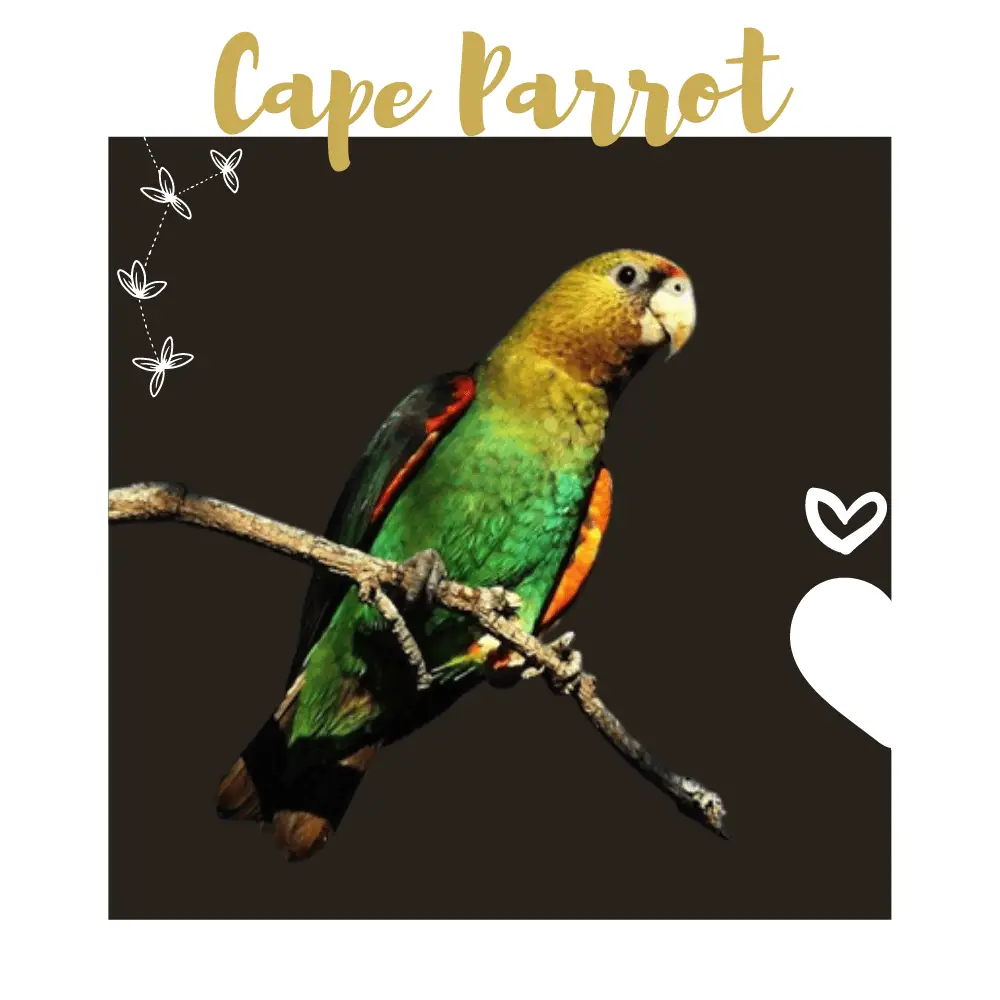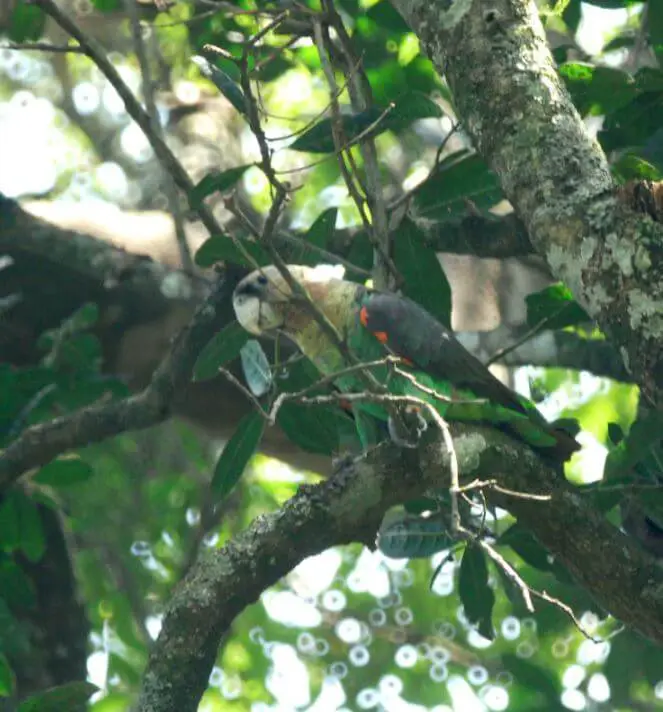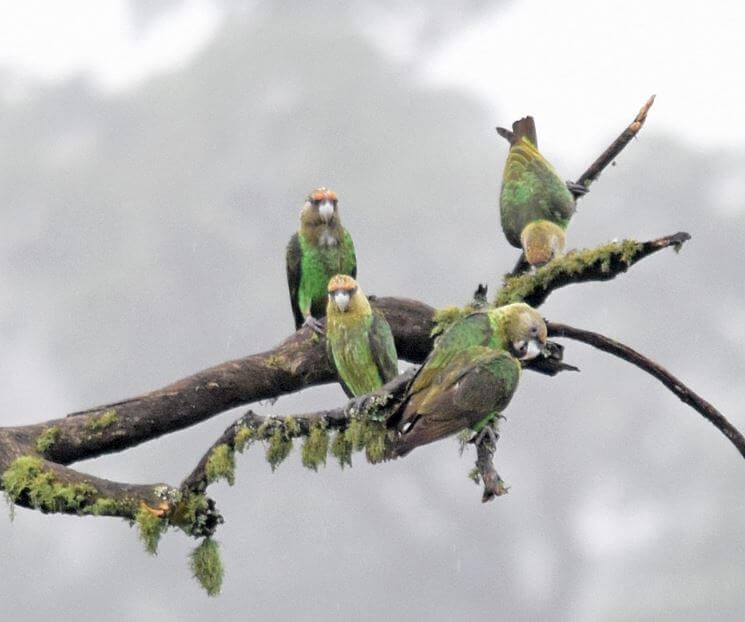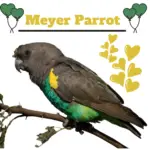
Cape parrot size
Cape Parrot 30–36 cm; 295–401 g. Head, throat, and neck yellowish-brown; body and wings dark green; thighs and outer edges of wings orange-red; tail and flight-feathers black. Bill large.

Some yellow feathers or other plumage abnormality in ~20% of specimens. Female typically has red forehead. The juvenile has a brownish-olive head and neck, reddish ear-coverts, without red on the tibia and wing edge.
Systematics History
Sometimes thought to form a parapatric species pair with P. Guglielmi. The trend to treat nominate robust as a separate species endemic in South Africa has gathered momentum in recent years,
but published attempts at justification were hampered by inadequate evidence and argument (e.g., claims of ecological specialization by robustus on Podocarpus failed to recognize that subspecies suahelicus occurs in Podocarpus zone in Tanzania); notion that robustus and suahelicus are parapatric unsubstantiated.
However, robust vs suahelicus (with fuscicollis) differs in its pale green vs pale gray head and neck; darker, blacker mantle, wing coverts, and flight feathers; generally less extensive or no red on the head of the female so that in adults the difference between the sexes is considerably less obvious;
SOURCE: Parrot Bliss
generally narrower, less obvious pale fringes to flight feathers; slightly smaller size (wing and tail) but with the distinctly smaller bill; higher frequency range of single notes; and clearly different note shapes.
Proposed subspecies (from Angola) are considered inseparable from suahelicus. DNA analyses support considering robust as a distinct species. Monotypic.
Subspecies
Monotypic.

Distribution
SE South Africa (S KwaZulu-Natal and Eastern Cape Provinces).
Habitat
Occupies montane mist-belt evergreen Podocarpus/Afrocarpus forest in the temperate zone at 1,000–1,700 m, but will exploit commercial orchards (pecan nuts, apples, pears, plums, apricots, and peaches) and semi-urban areas for food, especially at certain seasons (mainly April–September).
Movement
Some populations or parts of populations resident, with others wandering extensively during dry seasons in search of food.
Birds in the mountain forests of the southeastern Cape of South Africa, undertake 3 different types of excursions into lower areas: daily flights, short visits with overnight stops, and more extensive periodic wanderings.
These are largely prompted by the availability of Podocarpus fruits.
Diet and Foraging
Seeds, nuts, berries, and nectar. Often considered to be a specialist on Podocarpus, but in fact, the diet is considerably broader than this and in any case, in some years Podocarpus does not fruit.
Fruits of the yellow-woods, also seeds of introduced Acacia mearnsii.
Cape Parrot breeders
SOURCE: Parrot Wizard
In total at least 35 species of fruits have been recorded in the diet of this species. Drinks regularly at certain places in the early morning. Sometimes recorded in flocks of up to 100 (formerly 200) individuals.
Sounds and Vocal Behavior
Calls comprise short, rather pure-sounding, piercing whistles, predominantly up slurred or under slurred, combined with some more rolling, grating notes.
calls are either fairly pure and slurred, with no frequency bands, or harsh and buzzy (with many diffuse frequency bands),
or a combination of both (starting buzzy and ending with a pure whistle), with most slurred calls covering a frequency range of 1,000–2,500 Hz and reaching much higher frequencies
Breeding
Recorded August–February. Nest chiefly in a natural (but secondary) hole in the trunk of dead Podocarpus falcatus, other Podocarpus, Erythrina caffra, or Acacia melanoxylon, once a live Podocarpus henkellii, typically 6–12 m above ground; nest chamber 66 cm deep and 20 cm in diameter.
SOURCE: Parrot Wizard
Species will accept nest boxes, although it appears that it still strongly prefers those sited on dead snags.
Monogamous. Clutch 2–5 (usually 3–4) white eggs, size 34.0–36.4 mm × 27.9–28.7 mm, laid on consecutive days; incubation ~28–32 days, by the female alone; nestling period ~55–81 days, with young fed by both adults; the age of first breeding usually at 4–6 years in captive birds.
Breeding success in the wild is very poorly known, but in one study chick death and nesting, failure occurred after heavy rains and cold weather.
Conservation Status

VULNERABLE. CITES II. Generally scarce, but patchily common. Declines caused by habitat loss (clearance of Afromontane forest and selective logging of mature Afrocarpus/Podocarpus falcatus, P. latifolius, and P. henkelii trees for timber) and trade in live birds (the latter evidently continuing throughout the 1900s).
Persecution throughout the range, due to the perception that the species damages commercial harvests of pecan nuts, resulted in hundreds of mortalities in the 1970s.
Population believed to number 1,500–5,000 birds, although populations survive in more than 10 conservation areas, in 4 disjunct populations centered on the Amathole Mountains (Eastern Cape),
the Transkei highlands and coastal forest (Eastern Cape), southern KwaZulu-Natal in the foothills of the Drakensberg Mountains, and the Magoebaskloof area of Limpopo province.
Surveys during 1998–2012 showed a slight increase in South Africa, although this may be largely explained by an increase in coverage of suitable habitat and stabilization in the population since 2005. A conservation action plan has been developed for the species.




















